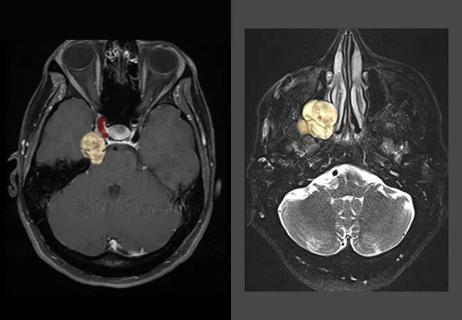A range of pituitary tumor-related conditions all benefit from a multidisciplinary approach
Although usually noncancerous, pituitary tumors are complex disorders and can produce multifaceted effects that manifest throughout the body. For this reason, their optimal management often requires a multidisciplinary approach.
Advertisement
Cleveland Clinic is a non-profit academic medical center. Advertising on our site helps support our mission. We do not endorse non-Cleveland Clinic products or services. Policy
“For the most favorable outcomes, it’s important that patients with pituitary tumors be treated at a dedicated pituitary center with various specialists who have expertise in dealing with these rare conditions,” says neuroendocrinologist Divya Yogi-Morren, MD, Medical Director of Cleveland Clinic’s Pituitary Center.
In the latest episode of Cleveland Clinic’s Neuro Pathways podcast, Dr. Yogi-Morren joins neurosurgeon Pablo Recinos, MD, Section Head of Skull Base Surgery at Cleveland Clinic, to explore the essentials of managing pituitary tumors and other pituitary disorders. They jointly cover the following:
Click the podcast player above to listen to the 36-minute episode now, or read on for a short edited excerpt. Check out more Neuro Pathways episodes at clevelandclinic.org/neuropodcast or wherever you get your podcasts.
This activity has been approved for AMA PRA Category 1 Credit™ and ANCC contact hours. After listening to the podcast, you can claim your credit here.
Podcast host Glen Stevens, DO, PhD: Tell us about the diagnostic workup for a patient with a suspected pituitary tumor.
Divya Yogi-Morren, MD: We of course use evidence-based guidelines from the major endocrine societies to standardize our diagnostic approaches and inform our treatment decisions. Basically, we begin with the hormone evaluation, which I've already spoken about. We also have to do dynamic testing for pituitary tumors — sometimes to evaluate pituitary reserve, but also to evaluate the behavior of the tumor and how the tumor is producing its hormones. That's critical from the endocrine standpoint.
Advertisement
We also use MRI, which is the gold standard for visualizing pituitary tumors. Sometimes we also have to do something called inferior petrosal sinus sampling. This involves sampling blood from the inferior petrosal sinuses that drain the pituitary and then measuring hormone levels there. We enlist our neurointerventional radiologist colleagues to perform that procedure.
When it comes to monitoring, we also need to do visual field testing with our neuro-ophthalmologist. So we definitely need a variety of tools and specialists in order to diagnose these conditions correctly before patients can undergo surgery or radiation or any other intervention.
Glen Stevens, DO, PhD: I imagine that some providers out there may just order an MRI. But you have a very specific protocol where you do a pituitary-specific MRI and obtain the important sequences in that area, correct?
Pablo Recinos, MD: Absolutely. And it actually depends on whether we're looking from a diagnostic perspective or from a surgical perspective. In the latter context, we use MRI to provide GPS-like image guidance to inform the surgery.
Advertisement
Advertisement

Analysis examines surgical resection of rare pituitary tumors

Randomized controlled trial finds no quality-of-life benefit after standard pituitary tumor surgery

Novel approach begins reinnervation before tumor resection, preserving a young woman’s smile

Researchers use AI tools to compare clinical events with continuous patient monitoring

Combining dual inhibition with anti-PD1 therapy yielded >60% rate of complete tumor regression

Insights into the choice between craniotomy and endoscopic endonasal approaches

An update on the technology from the busiest Gamma Knife center in the Americas

Real-time adjustments may help reduce bothersome dyskinesias